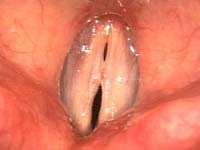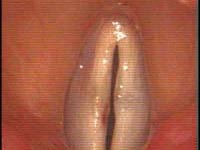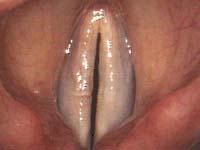Medical
No medications were recommended.
Behavioral modification is the initial treatment of these mucosal lesions and is likely a lifelong treatment for this patient. It is seldom someone can change their personality but it is possible for someone to manage their behavior. She is a severely impaired singer, yet it is usually not the singing that is the problem. More often it is the amount of talking that goes on daily. She rates herself a 4 and 4 on the talkativeness and loudness scales, but does talk and sing extensively at school. This usage carries over into home life with choral practice and performance.
Many times managing talkativeness will reduce a vocal fold swelling to an acceptable size such that the voice becomes dependable and acceptable to the patient, though the capillary ectasia on the vibratory margin makes this a difficult managment problem since that will likely swell with moderate usage or rupture intermittantly.
Speech therapy was again tried and was very helpful in controlling the amount and style of vocal use yet failed to prevent repeated hemorrhage.
After behavioral management surgery was indicated since the patient desired further improvement. Surgery is directed at removing only the mucosal lesion and preserving as much of the intermediate and deep layers of the vocal fold as possible.
With an appropriately delicate touch, these polyps were removed most successfully. Lasering of the vessel on the vocal fold margin successfully removed these ectasias. She experienced a substantial improvement.
|



